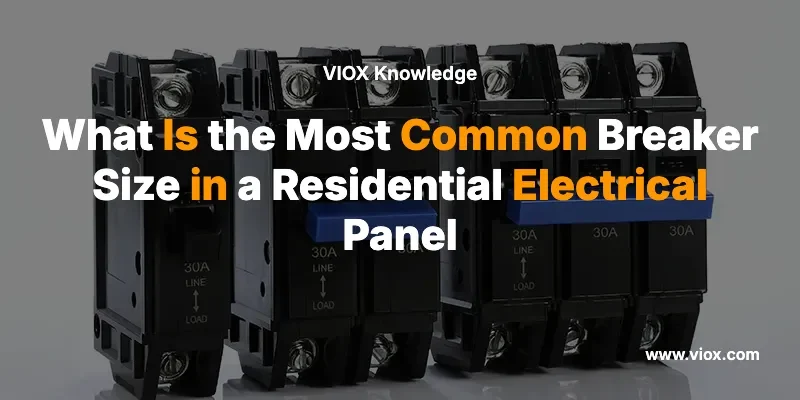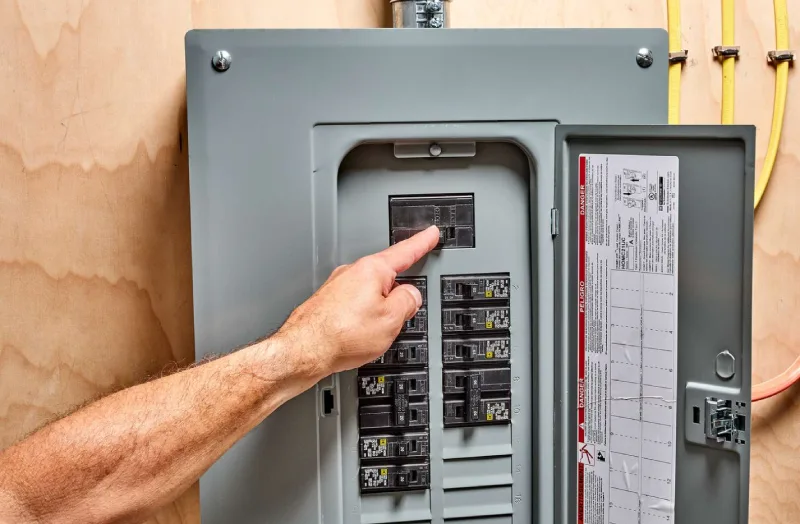Respuesta Rápida: The most common breaker size in residential electrical panels is 15 amp, followed closely by 20 amp breakers. These two sizes typically account for 60-70% of all breakers in a standard home electrical panel, with 15 amp breakers protecting general lighting circuits and 20 amp breakers serving kitchen outlets, bathrooms, and other high-demand areas.
Understanding Residential Circuit Breaker Basics
Disyuntores serve as the critical safety mechanism in your home’s electrical system, automatically shutting off power when circuits become overloaded. Understanding breaker sizes helps homeowners make informed decisions about electrical upgrades, troubleshooting, and safety compliance.
Why Breaker Size Matters for Home Safety
The amperage rating on a circuit breaker determines how much electrical current can safely flow through that circuit before the breaker trips. Using incorrectly sized breakers can lead to:
- Peligros de incendio from overloaded circuits
- Daños en el equipo from insufficient power supply
- Violaciones del código during home inspections
- Insurance claim denials after electrical incidents
Complete Breakdown of Standard Residential Breaker Sizes
15 Amp Breakers: The Most Common Choice
Usage Percentage: 35-40% of residential breakers
Aplicaciones principales:
- General lighting circuits throughout the home
- Bedroom outlets (non-AFCI areas)
- Living room standard outlets
- Hallway and closet lighting
Wire Gauge Required: 14 AWG copper wire
Maximum Safe Load: 12 amps (80% of rated capacity)
Consejo De Expertos: While 15 amp breakers can handle 15 amps, the National Electrical Code (NEC) recommends continuous loads should not exceed 80% of the breaker rating, or 12 amps for 15 amp circuits.
20 Amp Breakers: The Versatile Workhorse
Usage Percentage: 25-30% of residential breakers
Aplicaciones principales:
- Kitchen counter outlets (GFCI protected)
- Bathroom outlets and lighting
- Laundry room circuits
- Garage outlets
- Outdoor outlets (GFCI protected)
Wire Gauge Required: 12 AWG copper wire
Maximum Safe Load: 16 amps (80% of rated capacity)
Higher Amperage Breakers: Specialized Applications
| Tamaño del disyuntor | Percentage of Panel | Aplicaciones comunes | El Calibre De Alambre |
|---|---|---|---|
| 30 amperios | 10-15% | Electric dryers, water heaters | 10 AWG |
| 40 amperios | 5-8% | Cocinas eléctricas, grandes unidades de aire acondicionado | 8 AWG |
| 50 amperios | 3-5% | Electric ranges, RV outlets | 6 AWG |
| 60+ Amp | 2-3% | Hot tubs, electric vehicle chargers | 4 AWG or larger |
Regional Variations in Breaker Size Distribution
Modern Construction Trends (2020-2025)
Recent building codes and lifestyle changes have shifted breaker size preferences:
- Increased 20 amp circuits: Modern homes typically have more 20 amp circuits for increased device loads
- AFCI requirements: Arc-fault circuit interrupters are now mandatory for most 15 and 20 amp bedroom circuits
- EV preparation: New construction often includes provisions for 40-50 amp EV charging circuits
Older Home Considerations (Pre-1990)
Homes built before 1990 may have different distributions:
- Higher percentage of 15 amp circuits: Older homes relied more heavily on 15 amp circuits
- Fewer kitchen circuits: Older kitchens may have insufficient 20 amp circuits for modern appliances
- Panel upgrade needs: Many older panels require updates to meet current electrical demands
How to Determine Your Panel’s Breaker Sizes
Step-by-Step Identification Process
- Locate your electrical panel (generalmente en el sótano, garaje o lavadero)
- Abra la cubierta del panel carefully (turn off main breaker if unsure)
- Read breaker labels – amperage is printed on each breaker handle
- Create an inventory listing each breaker size and its protected circuit
- Verify circuit purposes using the panel schedule (if available)
Safety Precautions When Inspecting Your Panel
- Never touch exposed wires or metal components inside the panel
- Use a flashlight rather than overhead lighting when inspecting
- Keep the area dry – never inspect panels with wet hands or in damp conditions
- Call a professional if you notice burning smells, corrosion, or damaged components
When to Upgrade Your Electrical Panel Breakers
Signs You Need Professional Assessment
Immediate Red Flags:
- Breakers trip frequently without obvious cause
- Burning smells from the electrical panel
- Lights dimming when large appliances turn on
- Warm or hot breaker handles
- Visible corrosion or damage to breakers
Capacity Upgrade Indicators:
- Adding new high-demand appliances (AC units, electric vehicles)
- Kitchen or bathroom renovations requiring additional circuits
- Home additions requiring expanded electrical service
- Converting from gas to electric appliances
Professional vs. DIY Considerations
Contrate siempre a un electricista autorizado para:
- Installing new breakers or circuits
- Upgrading panel capacity
- Any work involving the main breaker
- Solución de problemas eléctricos
Homeowner-Friendly Tasks:
- Identifying and labeling existing circuits
- Resetting tripped breakers
- Basic electrical load calculations
- Planning electrical upgrades before contractor consultation
Cost Considerations for Breaker Replacement and Upgrades
Typical Sustitución Costs (2025 Pricing)
| Tipo de servicio | Rango De Costo | Factores que afectan el precio |
|---|---|---|
| Single breaker replacement | $150-$300 | Breaker type, accessibility, local rates |
| Multiple breaker upgrade | $500-$1,200 | Number of circuits, wire replacement needs |
| Panel capacity upgrade | $1,500-$4,000 | Current panel condition, electrical service size |
| Complete panel replacement | $2,000-$6,000 | Home size, complexity, local permitting costs |
Factors That Increase Project Costs
- Older home wiring: May require extensive rewiring with new circuits
- Code compliance updates: Bringing older installations up to current NEC standards
- Permit requirements: Municipal permits and inspections add time and cost
- Access challenges: Difficult-to-reach panels increase labor costs
Frequently Asked Questions About Residential Breaker Sizes
¿Puedo reemplazar un disyuntor de 15 amperios por uno de 20 amperios?
No, this is dangerous and code-violating. The breaker size must match the wire gauge in the circuit. Installing a larger breaker on undersized wire creates a fire hazard because the wire can overheat before the breaker trips.
Why do some circuits use 15 amp breakers instead of 20 amp?
Cost and necessity. 15 amp circuits with 14 AWG wire cost less to install than 20 amp circuits requiring 12 AWG wire. For lighting and low-demand outlet circuits, 15 amps provides adequate capacity while reducing installation costs.
How many outlets can be on a 15 amp circuit?
Generally 8-10 outlets, but the actual limit depends on the expected electrical load rather than the number of outlets. Bedrooms might safely have 10 outlets on a 15 amp circuit, while a home office might max out at 6 outlets due to computer equipment.
Do newer homes have different breaker size distributions?
Yes, significantly. Homes built after 2010 typically have more 20 amp circuits due to increased electrical demands from modern devices, appliances, and code requirements for kitchen and bathroom circuits.
What’s the difference between single-pole and double-pole breakers?
Voltage and applications. Single-pole breakers (15, 20, 30 amp) serve 120V circuits, while double-pole breakers (typically 30+ amp) serve 240V circuits for large appliances like dryers, ranges, and air conditioners.
Planning Your Electrical Future: Smart Breaker Strategies
Preparing for Modern Electrical Demands
Today’s homes require more electrical capacity than ever before. Consider these trends when planning electrical upgrades:
- Integración de casa inteligente:
- Additional 20 amp circuits for device charging stations
- Dedicated circuits for smart home hubs and network equipment
- Upgraded lighting circuits for smart switches and dimmers
- Electric Vehicle Preparation:
- 40-50 amp circuits for Level 2 EV charging
- Upgraded main panel capacity to handle additional load
- Future-proofing for multiple EV charging stations
- Energy Efficiency Upgrades:
- Heat pump systems requiring 30-60 amp circuits
- Solar panel inverter circuits (typically 30-50 amp)
- Battery backup systems requiring dedicated high-amperage circuits
Conclusion: Making Informed Electrical Panel Decisions
Understanding that 15 amp and 20 amp breakers comprise the majority of residential electrical panels helps homeowners make informed decisions about their electrical systems. While 15 amp breakers remain the most common for general lighting and outlet circuits, the trend toward 20 amp circuits reflects increasing electrical demands in modern homes.
Relacionados con la
GFCI vs AFCI: La guía completa sobre interruptores de seguridad eléctrica
Cómo reemplazar un disyuntor principal
IEC 60898-1 vs IEC 60947-2: Guía completa sobre las normas de interruptores eléctricos






